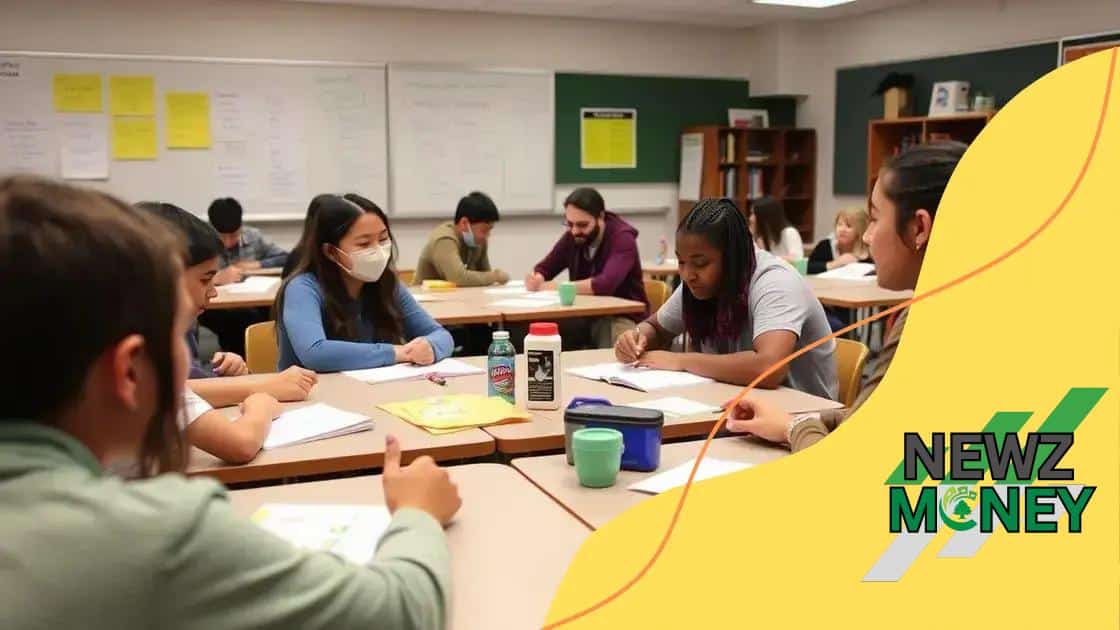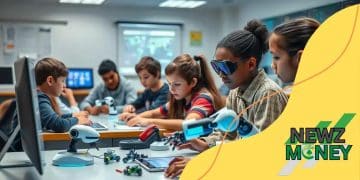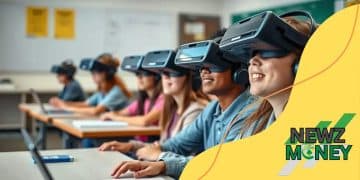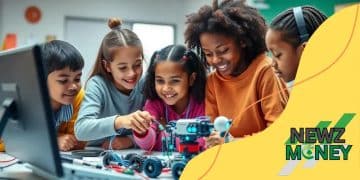Financial literacy education for middle school students: why it matters

Financial literacy education for middle school students equips them with essential skills for budgeting, saving, and making informed financial decisions, fostering a secure financial future.
Financial literacy education for middle school students serves as a crucial foundation for their future financial well-being. But have you ever wondered how early lessons in budgeting can shape their decision-making? Let’s dive into the essentials.
Understanding financial literacy
Understanding financial literacy is essential for young people as they prepare for their future. It involves knowing how to manage money effectively, make informed decisions, and set financial goals. A solid grasp of financial principles lays the groundwork for a successful and secure life.
Defining Financial Literacy
At its core, financial literacy means having the skills and knowledge to understand and use various financial skills. This includes budgeting, saving, investing, and understanding credit. Learning these concepts early helps students make smart choices.
Key Principles of Financial Literacy
There are some basic principles that form the foundation of financial literacy:
- Understanding money management
- The importance of saving
- How to create and stick to a budget
- Recognizing the value of credit
By grasping these key areas, students can have a brighter financial future. Knowing how to budget allows them to plan for their expenses, while understanding credit will help them avoid pitfalls later in life.
As students delve deeper into the world of finance, they learn about interest rates, loans, and investments. Grasping these concepts allows them to make informed decisions about spending and saving as they mature.
Benefits of Being Financially Literate
Having a solid background in financial literacy offers numerous benefits:
- Improved budgeting skills
- Better decision-making when it comes to money
- Increased confidence in financial matters
- Ability to plan for future goals
In conclusion, understanding financial literacy is crucial for middle school students. It equips them with the tools they need to navigate their financial lives successfully, empowering them for years to come.
Key components of financial education
Key components of financial education are essential for students to navigate their financial future. Understanding these components helps them build essential skills for managing money wisely.
Essential Topics in Financial Education
There are several important topics that make up comprehensive financial education:
- Budgeting: Learning to create and stick to a budget ensures students know how to manage their money.
- Saving: Teaching the value of saving helps students prepare for expenses and emergencies.
- Investing: Understanding how to invest wisely can grow wealth over time, providing greater financial security.
- Debt Management: It is crucial for students to learn about credit and how to handle debt responsibly.
By exploring these topics, students gain a well-rounded understanding of how to handle their finances. Budgeting skills lead to confidence in spending, while saving teaches the importance of preparing for unexpected situations.
The Role of Real-Life Applications
Incorporating real-life scenarios is vital for engaging students. When they see how financial concepts apply to daily life, they can connect theory to practice. For instance, discussing scenarios like buying a car or saving for college makes the lessons more tangible.
As students learn about budgeting, they can create their personal budgets using their allowances or part-time job earnings. This personalized approach encourages realistic practice and responsibility.
Interactive Learning Strategies
Using interactive methods enhances the learning experience. Activities such as games, simulations, and group projects can make the content more engaging:
- Simulations of real-world budgeting help students understand financial decisions.
- Group projects can encourage discussions about financial topics.
- Games centered around economic principles capture interest and foster teamwork.
Ultimately, focusing on these key components of financial education prepares students for a successful financial future. Equipped with the right knowledge and skills, they can tackle challenges confidently.
Practical exercises for students

Practical exercises for students are essential for reinforcing financial concepts learned in the classroom. Engaging students in hands-on activities helps them apply what they know to real-life situations.
Creating Budgets
One effective exercise is to have students create their own personal budgets. They can list their expected income from allowances or part-time jobs and plan out their expenses, such as shopping or outings. This exercise provides a realistic look at how budgeting works.
Saving Challenges
To teach the importance of saving, a savings challenge can be implemented:
- Students can set a saving goal, like buying a new gadget.
- They can track their progress weekly to see how their savings grow.
- Discussing their strategies with classmates can motivate them.
Savings exercises show students the benefits of setting aside money for future needs or wants, making the concept more tangible.
Role-Playing Scenarios
Role-playing is another dynamic way to engage students. By creating real-life scenarios, such as buying a car or planning a trip, students can practice handling budgets and making spending decisions.
For example, in a car-buying scenario, students could research prices, evaluate additional costs like insurance, and negotiate their budget. This not only teaches them how to make financial decisions but also enhances their critical thinking skills.
Investment Simulations
Investment simulations can introduce students to the world of investing without any real financial risk. They can use virtual money to buy stocks and observe how their choices impact their portfolio over time.
- Students can learn to evaluate trends in the stock market.
- Discussing their investments with peers can lead to deeper understanding.
- This teaches them about risk management and market fluctuations.
Through these practical exercises for students, learners gain essential financial skills that prepare them for real-world challenges. Each activity offers not just knowledge, but also the confidence to make informed financial decisions in life.
Building effective teaching strategies
Building effective teaching strategies is crucial for delivering successful financial literacy education. A good strategy keeps students engaged while providing the knowledge they need to manage their finances.
Encouraging Active Participation
One effective method is to encourage active participation. Involving students in discussions and group activities makes learning fun and memorable. Educators can use questions that prompt students to think critically about their financial choices.
Using Real-World Examples
Incorporating real-world examples into lessons helps students relate to the material:
- Discussing scenarios like buying a car or saving for college makes concepts tangible.
- Analyzing advertisements can show how marketing affects purchasing decisions.
- These examples enhance understanding and encourage students to apply what they learn.
Connecting lessons to their daily lives makes the information more relevant and exciting.
Implementing Interactive Activities
Interactive activities, such as games or simulations, reinforce learning. Activities can include:
- Budgeting challenges where students plan a mock event.
- Stock market simulations to help them understand investments.
- Group projects that encourage collaboration and problem-solving.
These hands-on experiences make learning engaging, helping students grasp complex ideas in a fun way. When students are involved, they are more likely to retain information.
Differentiating Instruction
Recognizing that not all students learn the same way is essential. Differentiating instruction allows teachers to cater to various learning styles:
- Visual learners may benefit from charts and graphs.
- Auditory learners can engage with podcasts or group discussions.
- Kinesthetic learners thrive with hands-on activities.
By addressing different learning preferences, teachers can ensure that all students have the opportunity to succeed.
In summary, building effective teaching strategies is vital in financial literacy education. By using active participation, real-world examples, interactive activities, and differentiation, educators can create a dynamic and engaging learning environment.
The role of parents in learning
The role of parents in learning about financial literacy is crucial for middle school students. Parents can provide guidance and support, helping their children navigate the world of money.
Setting a Good Example
One of the most important ways parents can influence their children is by setting a good example. When parents manage their finances responsibly, children learn valuable lessons about budgeting and saving. For example, openly discussing household expenses can teach kids the importance of financial planning.
Encouraging Open Discussions
Parents should encourage open discussions about money. By talking about financial decisions, they create a safe space for questions. Here are some conversation starters:
- Discuss how to save for a family vacation.
- Explain the importance of emergency funds.
- Talk about the value of money and how to earn it.
These discussions help demystify finances and empower students to make informed decisions.
Supporting Financial Education at School
Parents can also actively support their children’s financial education in school. They can attend school events that focus on financial literacy or participate in workshops. Showing interest in these topics reinforces their importance.
Additionally, parents can work with teachers to understand what their children are learning. This collaboration ensures that they are on the same page and can reinforce lessons at home.
Creating a Financial Literacy Environment
Creating an environment that values financial literacy is key. Parents can foster this by:
- Providing educational resources like books and games about money.
- Involving children in family budgeting tasks.
- Encouraging them to set their financial goals.
These actions empower children to take charge of their financial education, helping them learn essential skills for the future.
By playing an active role, parents can significantly enhance their children’s understanding of financial matters. This support nurtures confidence and prepares them for financial independence.
FAQ – Frequently Asked Questions about Financial Literacy Education
Why is financial literacy important for middle school students?
Financial literacy helps students make informed decisions about money, setting the stage for a successful financial future.
How can parents support their children’s financial education?
Parents can engage in open discussions about finances and model good money management habits.
What are some effective teaching strategies for financial literacy?
Utilizing real-world examples and interactive activities can significantly enhance students’ understanding and interest.
What practical exercises can help students learn about budgeting?
Activities like creating personal budgets and participating in savings challenges provide hands-on experience in managing money.





